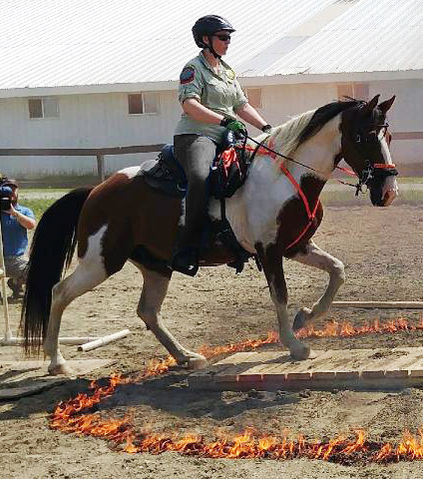
Why Horses?

WHAT DO HORSES ADD TO THE SEARCH?
-
Horses are slower than ATVs, enabling the rider to easily search for clues and for the missing subject.
-
Horses are faster than people on foot, enabling the team to quickly move from staging area to search area, move quickly between disparate search areas, and return from the outer reaches of their search area without the Command Post needing to deploy resources to retrieve the MSAR team.
-
Horses are quieter than ATVs, enabling both the horse and rider to listen for voices, whistles, and other signals.
-
Horses find their own best route down a path, enabling the rider to focus on looking for clues and for the missing subject.
- A horse/rider team covers a wide angle of vision, about 5-8' off the ground. Being on the back of a horse elevates the riders' eyes to about 8' off the ground, giving a very different angle of view to the ground than a walker or ATV rider would have. Meanwhile, the horses' eyes are about the same height as those of a person on foot would be.
-
Because horses are prey animals, they're already looking for things that are out of place!
-
Horses can see, hear, and smell things long before we can, and their reactions (stop, look and point their ears in that direction, sniff/snort/blow, etc) alert us that there's something we need to check out.
HORSES' SENSES:
-
Hearing: Horses have very keen hearing. Their short, pointed ears act like small radar antennas, picking up sounds too quiet for the rider to detect. Horses’ ears can swivel around to pick up sounds from almost any direction; usually they are also looking at whatever they point each ear toward.
-
Vision: Horses’ eyes are larger than any other land animal except ostriches, and they have excellent long-range vision both at night and in the daytime. Each eye can see things above, below, behind, and in front. The two eyes can be moved independently, each in a half-circle. Watch the horse’s ears, they can help indicate where he is looking!
-
Smell: Horses have a well-developed sense of smell. Their nostrils and sinuses are very large and can pick up scents from long distances. Horses can pick up foul and unusual odors, and their reaction will signal the rider.
HORSES' WORK ETHIC: Just like SAR dogs, a good SAR horse knows when s/he is working, because the gear they wear, and the atmosphere/vibe around them, are both different. On a search, they tend to be much less prone to alert at irrelevant animals such as a chipmunk or bird, are more willing to walk slowly, and are more patient when standing tied. They know their job is to remain calm, choose a safe path, and look/listen and smell for people and things that don't "belong". This helps the rider, who is then able to better focus on their own job, looking for clues and the missing subject.
APPROPRIATE SEARCH AREAS: MSAR teams are capable of searching varied terrain, including light woods, fields, roads, ATV trails, hiking trails, wild game trails, and even suburban neighborhoods. It is not generally safe for MSAR teams to search extremely steep areas, swampy areas, or areas with a lot of "slash" left over from logging operations. Thick woods can be difficult for MSAR teams to search as effectively as people walking on foot, but it can be done as long as the footing is safe.
COVERAGE AREA: Because our members are located all over the state, we can respond to searches anywhere in Maine.
RESPONSE TIME: Being put on early standby is very helpful because we do require longer preparation time than other types of units. For one thing, we have a lot more gear... we carry 48-hour supplies both for ourselves and our horse. Also, many of our members do not keep their horses at home and their trailers hooked up. With proper notice, we can usually have a team of two horses/riders (we always search in pairs for safety) at the Command Post very close to the requested time.
ONGOING TRAINING: Most of our mounted teams are fully certified under the Maine Association for Search and Rescue (MASAR) standards; those who are not can only deploy on a search with a fully-certified member. In addition, we schedule relevant new trainings throughout the year as available, such as
Equine Air Scent Detection, Equine First Aid, Large Animal Rescue, Helicopter Training, Cadaver Training, Crime Scene Preservation, etc. We train together about once a month but each member is required to submit documentation for a certain number of independent trainings per year. Also, most of our horses have another "job", which often includes parades, "trail riding" within urban city/town limits, long distance competition, and other disciplines that constantly reinforce the traits necessary for a useful SAR horse.










